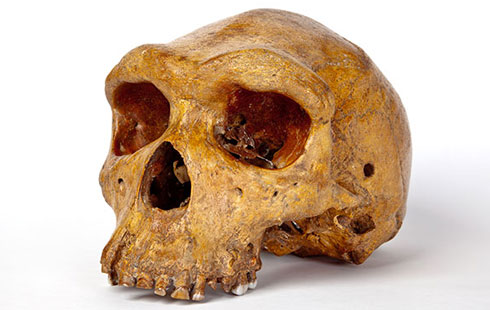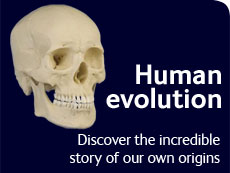Broken Hill skull
The Broken Hill skull was the first early human fossil found in Africa. Now identified as the species Homo heidelbergensis, the most likely ancestor to modern humans, it is still the finest known example of its kind and continues to reveal exciting new insights about human evolution.

Lead mine waste heaps near Kabwe (formerly called Broken Hill) mine, Zambia. © Carl A O’Keeffe MA, ARPS
An alarming discovery
This pivotal specimen was very nearly lost to science when workers in Zambia's Broken Hill mine came face to face with it in 1921. Luckily, one of them had the courage to rescue the eerie relic.
The area has since been so heavily mined that all the material around where the skull was found has gone, and with it clues about its age and history. But the bones are so well preserved they are still extremely telling.
African origins
Fifty years before the Broken Hill discovery, Charles Darwin predicted humans had evolved in Africa because African apes are our closest living relatives. This skull was the first evidence showing his intuition was right. Until then, early human fossils mainly consisted of Neanderthals in Europe and Homo erectus in Asia.
In the 1980s, Natural History Museum scientist Chris Stringer and other researchers began to develop the Out of Africa model of human evolution - that we all descend from a recent ancestral African population. It became widely accepted.
So far we know there have been about 20 human-like species since we diverged from chimpanzees 6 million years ago. Modern humans (the modern form of Homo sapiens) emerged about 200,000 years ago and are the only survivors.

Professor Chris Stringer studying the Broken Hill skull.
Uprooting the family tree
Evidence suggests that the species Homo heidelbergensis was the ancestor of both modern humans and Neanderthals, Homo neanderthalensis. But research led by Museum scientists indicates that this particular fossil could be much younger than expected.
If it is less than 300,000 years old, it would be close in age to the first modern humans, leaving its actual evolutionary position in doubt. This would make us reconsider human evolution, but the research is ongoing.
Our scientists now have a new theory. Instead of a linear evolution, with one species replacing the last, perhaps Africa was a melting pot of interbreeding human species, where Broken Hill Man lived alongside the evolving lineage of modern humans and others. This one skull has made us rethink what we thought we knew.
Further information
- Visit the Broken Hill skull in our new Treasures Cadogan Gallery. It will be alternated with the Neanderthal skull.
- Explore what fossils have revealed about Homo heidelbergensis and meet other early humans.
- Find out more about where and when modern humans evolved.
Vote for your favourite treasure
Is this your favourite Museum treasure? Let us know by voting in our poll.

